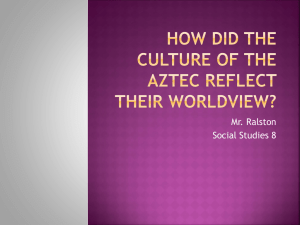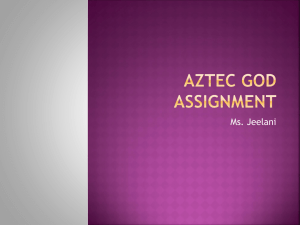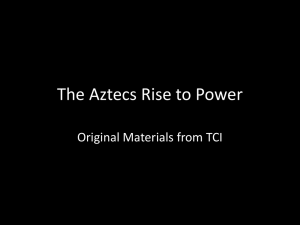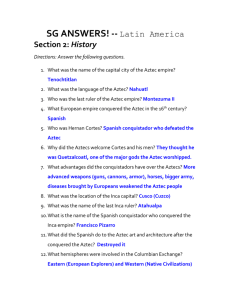How Did the Culture of the Aztec Reflect Their
advertisement
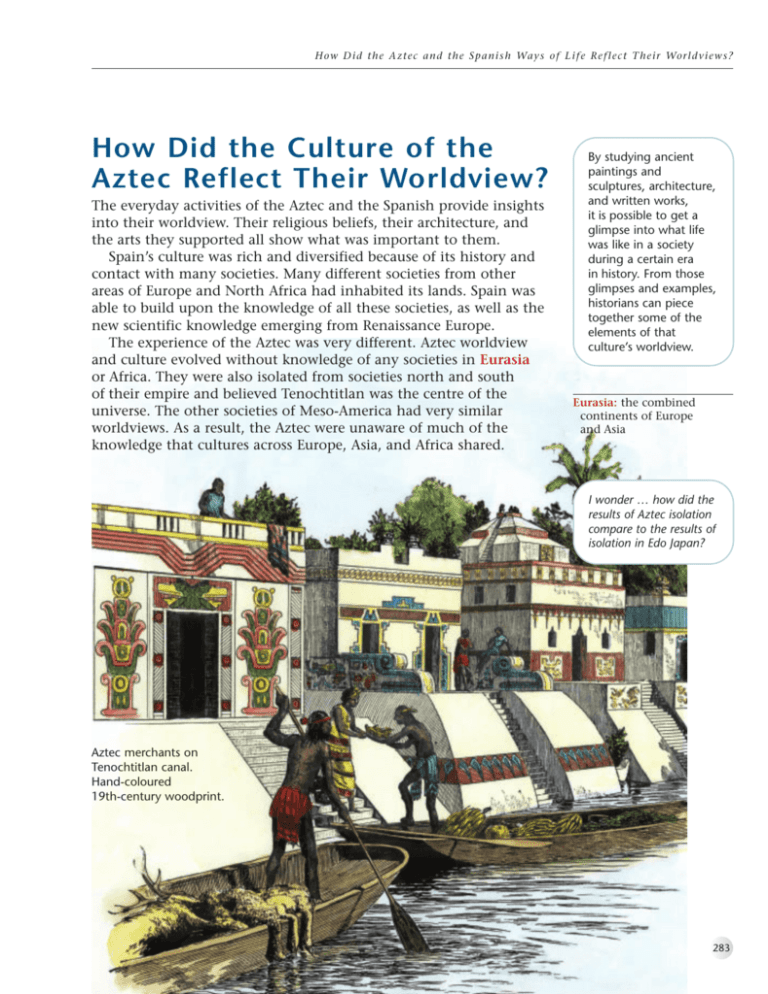
H o w D i d t h e A z t e c a n d t h e S p a n i s h Wa y s o f L i f e R e f l e c t T h e i r Wo r l d v i e w s ? How Did the Culture of the Aztec Reflect Their Worldview? The everyday activities of the Aztec and the Spanish provide insights into their worldview. Their religious beliefs, their architecture, and the arts they supported all show what was important to them. Spain’s culture was rich and diversified because of its history and contact with many societies. Many different societies from other areas of Europe and North Africa had inhabited its lands. Spain was able to build upon the knowledge of all these societies, as well as the new scientific knowledge emerging from Renaissance Europe. The experience of the Aztec was very different. Aztec worldview and culture evolved without knowledge of any societies in Eurasia or Africa. They were also isolated from societies north and south of their empire and believed Tenochtitlan was the centre of the universe. The other societies of Meso-America had very similar worldviews. As a result, the Aztec were unaware of much of the knowledge that cultures across Europe, Asia, and Africa shared. By studying ancient paintings and sculptures, architecture, and written works, it is possible to get a glimpse into what life was like in a society during a certain era in history. From those glimpses and examples, historians can piece together some of the elements of that culture’s worldview. Eurasia: the combined continents of Europe and Asia I wonder … how did the results of Aztec isolation compare to the results of isolation in Edo Japan? Aztec merchants on Tenochtitlan canal. Hand-coloured 19th-century woodprint. 283 O u r Wo r l d v i e w s Chapter 8 Religious Beliefs and Practices impersonate: to pretend to be someone or something else, either to entertain or to deceive Incense burner with representations of Tezcatlipoca known as Smoking Mirror, the god of night and sorcery. An image of Smoking Mirror is on the top of the handle. The turkey-claw handle also represents the god. He was a very powerful deity, a dark force who could forecast the future and a person’s destiny. In the Aztec worldview, humans played only a small role in the world. Their duty was to fight and die for the gods and to keep the world order in balance. They believed their futures were already determined by the gods, and that their life after death depended on the gods’ decisions and living a balanced life. They believed everything in nature was divine. The Aztec believed they were Huitzilopochtli’s chosen people; it was their duty to make sure the sun never died and the Earth survived. They believed in many gods and goddesses, both male and female — those of life and death and those of creation and destruction. Each god or goddess was dual in nature, neither purely good nor purely evil. Each had a personality and a well-defined role. The gods could transform themselves into earthly beings or items. Each of their gods had a physical image, often with both human and animal features. During religious festivals and ceremonies, many related to rain and fertility, individuals were chosen to impersonate the gods. Three gods dominated the Aztec religion: Huitzilopochtli, Tezcatlipoca, and Quetzalcoatl. Among the hundreds of other deities, the rain god and the god of springtime and growth were among the most important. Other gods were those of maize and fertility. Each neighbourhood had their personal patron deities. Each house had a shrine where family members would ask the gods for help and make offerings of thanks. Carving of Quetzalcoatl as the plumed serpent, from 1350–1521. Quetzalcoatl, the god of civilization and learning, had dozens of different roles. He was a great culture hero and equally at home on Earth or in the sky. He was often symbolized as a coiled plumed serpent. One story shows him as a light-skinned man disappearing across the sea, with promises to return in the future. 284 Huitzilopochtli, Aztec carving of stone, white shell, and obsidian, 1500. Huitzilopochtli, the war and sun god, was the special guardian of Tenochtitlan and the Aztec. He was born every morning with the sunrise and died every evening at sunset. Human sacrifices (sometimes warriors, sometimes other selected victims) allowed him to return each morning. H o w D i d t h e A z t e c a n d t h e S p a n i s h Wa y s o f L i f e R e f l e c t T h e i r Wo r l d v i e w s ? Ritual and Sacrifice It was the Aztec practice of human sacrifice that most collided with the Western worldview of the Spanish. The Aztec believed the world was created through sacrifice; their role was to maintain the universe in balance through their rituals and sacrifice. According to Aztec belief, their world, the fifth era of the sun, occurred when a god sacrificed himself to change into the sun to maintain human life. Unfortunately, he was unable to move across the sky. Other gods sacrificed themselves to assist him. It was the Aztec view that human behaviour could affect the stability of the universe and that it was through their rituals and sacrifices that the universe could continue to exist. They believed their offerings actually kept the gods alive and the universe in balance. Offerings often consisted of different foods, paper, liquid rubber, feathers, grasses, jewels, textiles, and the blood of animals, but the most important offering was human blood. The Aztec believed the gods prized human blood above all else. They were convinced that without human sacrifices, the Earth would dry up and the sun, moon, planets, and stars would not be able to travel across the sky. They believed their world would be destroyed. Human sacrifices were performed on altars at the top of their temples. These were large public events with elaborate ceremonies. Most important were the sacrifices at the main temple in Tenochtitlan, the heart of the empire. Aztec priests believed that the best nourishment for the gods was the still-living hearts of the sacrificed warriors. Some records show that at times, thousands of warriors were sacrificed in a single day. Wood and flint sacrificial knife, 1500. Museo Nacional de Antropologia, Mexico City. Medicine Bundles Among the sacred objects of the Aztec were bundles containing items used in their rituals and ceremonies. The bundles contained objects such as blessed corn, feathers, rubber, and precious stones. Each object referred to an important sacred episode or event. Each altepetl had a sacred bundle, called the hearth of the altepetl, that was associated with its patron god. The Aztec believed the medicine bundle for Huitzilopochtli contained the essence, the power, of the god. The bundles were carefully guarded, treated with the utmost respect and ritual, and were carried safely with the people whenever they had to migrate. The medicine bundle for Huitzilopochtli was kept in its place of honour in the main temple of Tenochtitlan. Priests of Tenochtitlan sacrifice victims to their gods. Medicine bundles are important to many of Canada’s First Nations. They are central to many traditional rituals and beliefs. 285 O u r Wo r l d v i e w s In 1552, Martinus de la Cruz, an Aztec physician, wrote the oldest known book on this continent about herbal medicine. It was later translated into Latin by another Aztec, Juannes Badianus. Both men had converted to Christianity. I wonder … how did Aztec healing knowledge compare to that of Alberta’s First Nations? Chapter 8 Medicine Aztec ideas about illness and medicine were a blend of religion, magic, and medicine: • religion — Certain gods were thought to either send illnesses or heal them. • magic — Certain illnesses were thought to be the result of black magic by some sorcerer. Anyone thought to be casting evil spells was condemned. • medicine — The Aztec had a great deal of knowledge of the healing properties of plants and minerals. Sometimes, physicians were viewed as healing sorcerers. The Arts Books and Codices Although the Aztec created hundreds of manuscripts, called codices, they had no alphabet. They used a form of picture-writing that included pictographs, ideographs, number symbols, and calendar symbols to record information. Scribes and priests recorded poetry, history, moral lessons, rituals, tribute lists, governmental records, and business records. Only the elite were taught to read these books or codices. The books were used to record the key ideas to help speakers remember information and stories told through the Aztec oral tradition. Codices were often written on deerskin, cloth, or ornate paper made from the fibres of the inner bark of fig trees. Information was painted on both sides of long paper strips. When a book was completed, it was folded accordion style so both sides could be viewed. The few codices that were not destroyed are almanacs and guides for living. Codex Borbonicus, religious calendar, the gods Tezcatlipoca and Quetzalcoatl devouring a man, early 1500s. Codex Fejervary-Mayer, pre-Conquest 1400–1521, partially unfolded, detailing the lore of the pochteca (merchants of the Aztec world). Liverpool Museum, Liverpool, Great Britain. 286 H o w D i d t h e A z t e c a n d t h e S p a n i s h Wa y s o f L i f e R e f l e c t T h e i r Wo r l d v i e w s ? Sculpture Most Aztec sculpture was religious in nature. Stone sculptures were often of gods and were placed inside and under temples. Smaller statues of animals, such as jaguars and snakes, highlighted the Aztec belief in the importance of maintaining a balance with the natural world. Some sculptures of people and everyday objects were also created. Many of the Aztec stone sculptures of the gods were not displayed above ground or out in the open, as is customary in European or Asian societies. The Aztec shared a worldview with other MesoAmerican cultures that divided the universe into three general levels. Humans lived on the middle level, Earth, but there were levels both above and below the ground. Statues were often placed below ground level in recognition of the underworld. The main temple in Tenochtitlan was thought to be the centre of the universe and the connection between the underworld and the heavens. Aztec stone sculptors used simple tools made from wood, stone, or fibre cords, yet their works were exquisitely detailed. None of the sculptures were signed by the sculptor. In Aztec society, artists and craftsmen passed their skills onto their sons who took up their trade when they became adults. A rc h i t e c t u r e The largest and grandest buildings in any city were the temples. The most magnificent of these were in the city of Tenochtitlan. Most of the architectural elements in these temples were borrowed from the earlier Teotihuacan and Toltec societies. However, the Aztec developed one distinct architectural design for their temples. The stepped pyramid form had been used by earlier societies, but the Aztec divided the pyramid at the top into two temples with two sets of stairs leading to them. The two halves of the Templo Mayor represented two sacred mountains. Templo Mayor: the major temple in the centre of Tenochtitlan, dedicated to the god Huitzilopochtli I wonder … how would believing that the centre of the world was my city affect my group’s worldview? Eagle vessel, 1502–1520. The hole on the back held the heart and blood of a sacrificial victim. Museo del templo mayor, Mexico City. Model of the temple area of Tenochtitlan, National Anthropological Museum, Mexico City 287 O u r Wo r l d v i e w s equinox: the two times of the year, around March 21 and September 21, when day and night are equal Chapter 8 The front of the temple looked west so that those who climbed the two broad stairways to reach the twin temples would go upward and eastward. The sun, during equinox, rose between the two shrines. Enormous stone serpent heads with long upward-curling snouts sat at the bottom of the stairs. At the top of the stairs, the temple of Tlaloc, god of rain, stood on the north side, and the temple of Huitzilopochtli, the sun god, on the south. Inside the temples, the walls were covered with murals and paintings. The interiors were quite small because the ceremonies took place outside in front of the crowds that would gather at the base of the pyramid. At the bottom of the Tlaloc stairway was a stone altar of a reclining man to receive offerings for rain. The sacrificial stone, on which humans were sacrificed, was at the entrance to Huitzilopochtli’s shrine. Featherwork and Luxury Items Gold pectoral (chest protector) in the form of the fire god, Mixtec. National Museum of Anthropology, Mexico City. Aztec prized feathers more than gold. Feathers were rare, delicate, and brilliantly coloured. Featherworkers were held in very high esteem. Although they created wonderful feather garments and ornaments, their most prized works were of ceremonial costumes, headdresses, and warrior shields. During official state ceremonies, officials, rulers, warriors, and all statues of the gods were covered with feather garments. Many luxury items such as jewels and ornaments had no religious importance but were created simply to satisfy the desires of the wealthy. Talented artisans created beautiful jewellery, ceramics, and mosaics. When he arrived in Tenochtitlan, the Spanish conquistador Hernan Cortés wrote to King Charles V of Spain describing the luxury products he saw: All these, in addition to their intrinsic worth are so marvelous that considering their novelty and strangeness they are priceless; nor can it be believed that any of the princes of this world, of whom we know, possess any things of higher quality. Brilliantly coloured feather headdress, sent by Cortés as a gift to King Charles V, Museum fur Volkerkunde, Vienna, Austria 288 H o w D i d t h e A z t e c a n d t h e S p a n i s h Wa y s o f L i f e R e f l e c t T h e i r Wo r l d v i e w s ? T h e I m p o r t a n c e o f Ti m e t o t h e A z t e c Every aspect of Aztec life was coordinated by two calendars. Similar to modern day, the Aztec had a 365-day solar yearly calendar. This, their main calendar, was called the xiuhtlapohualli (she-uh-tlah-poh-WAHLlee). The second important calendar was a ritual calendar called the tonalpohualli (toh-nahl-poh-WAHL-lee), based on a 260-day cycle. The xiuhtlapohualli was made up of 18 months, each having 20 days (360) and 5 extra (or useless) days at the end of the year, referred to as nemontemi (nay-mohn-TAY-mee). This calendar was in place long before the Europeans recognized there were 365 1/4 days in one year. Each month was named for a god and incorporated a religious festival dedicated to that god. Because this was a solar calendar, the festivals closely followed the seasons. The calendar regulated agricultural activities, such as planting and harvesting, and determined market days. Each year began with a festival to honour the god of rain, Tlaloc. The tonalpohualli calendar was composed of 13 numbers and 20 signs that represented an animal, a natural element such as water or grass, or an abstract idea such as movement. They combined to produce 260 individually named days. The sign for one day, for example, might be 3 Rabbit or 7 Flint. People were named for the day on this calendar on which they were born. Each day was associated with a specific fate that was good, bad, or indifferent. The Aztec believed that the day on which they were born would affect their destiny. The Aztec used this calendar to determine when many of their religious rituals and sacrifices should be performed. I wonder … how did the Aztec develop such an accurate calendar before the Europeans? This is the Aztec Calendar stone, or sunstone, one of the most famous symbols of Mexico. The original is a massive stone slab with a diameter of almost 3.5 metres. It was originally in Tenochtitlan’s temple complex and was unearthed in the area of the main cathedral in central Mexico City. 289 O u r Wo r l d v i e w s Chapter 8 The xiuhtlapohualli and the tonalpohualli calendars combined to form a third called the xiuhnolpilli (she-uh-nohl-PEEL-lee). This calendar had a cycle of 52 years, the time needed for the two calendars to go through their complete cycles and each reach their beginning on the same day. Each 52-year period was considered an era, somewhat equivalent to our century. The Aztec believed that at the end of each era, there was a possibility that the world would be destroyed if sacrifice and specific rituals were not carried out. All fires were put out throughout the land, statues made of wood or stone were thrown into the lakes, and houses were thoroughly cleaned. That evening, people climbed onto their rooftops, fearful that the world was going to end. Priests kindled a new flame on a freshly sacrificed human heart on the peak of a sacred mountain. The Aztec feared that if the flame could not be rekindled, the sun and their world would be destroyed. The flame from this holy fire was then carried to every home in the land to rekindle everyone’s home fires. REFLECT AND RESPOND 1. The Aztec believed that Tenochtitlan was the centre of the universe. What does this reveal about their worldview? How does this compare to the common European view of the universe before the Renaissance? 2. The end of the 52-year Aztec era was considered to be a time of great danger. For the Aztec, it was a key part of their religious belief. From our worldview, we might consider that to be a superstition. What are some superstitions we have in our worldviews? What do you think they say about our worldviews? 3. Aztec artists rarely showed any individual characteristics in their sculptures or paintings of humans. Most Aztec sculptures of people were very standard with few details to suggest any kind of individuality. What reasons might the artists have had for not depicting specific people? 290

